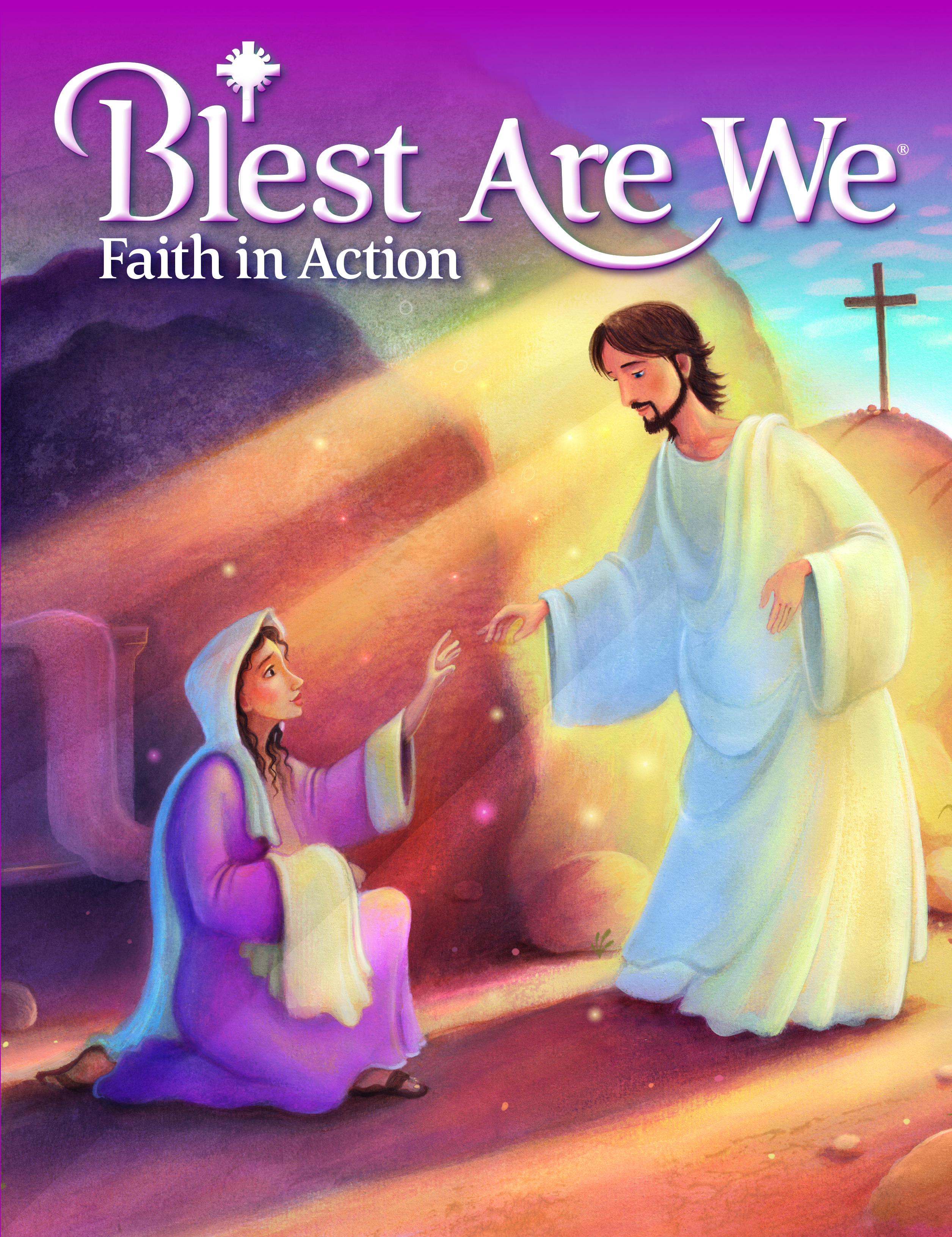Lent comes around every year, and it is a good thing! We are all called to continually be renewing our faith and growing in our relationship with Jesus Christ and with one another. We are called to be better Christians today than we were yesterday, and better tomorrow than we are today. This call to ongoing conversion can be described in the word, Metanoia. Metanoia is a Greek word the Gospels use for that two-fold process of turning from sin and toward God.
 Along with us adults, children first need to hear again and again the proclamation of the Good News, “the mighty works of God” (Evangelization in the Modern World, Pope Paul VI, 15). If our faith is alive, it will be aroused again and again as we mature as disciples.
Along with us adults, children first need to hear again and again the proclamation of the Good News, “the mighty works of God” (Evangelization in the Modern World, Pope Paul VI, 15). If our faith is alive, it will be aroused again and again as we mature as disciples.
What experiences can arouse the faith of children? Our faith formation classes in school and in the parish are a vital source of those faith experiences. We aim to make the most of the time we spend with our students and their families. Having programs and resources like Be My Disciples and Blest Are We Faith in Action, gives us the tools to be systematic about providing the content for formation that is ongoing. Download a worksheet on Repenting for Lent that works for multiple age groups.
Having Mercy on Ourselves. Growth and change can be hard. Along with teaching children about repentance and renewal, we need to teach them to be patient with themselves when they sometimes fail to be kind and loving. God is gentle with people, and we need to be gentle with ourselves. Teach children that God loves their efforts to do better each day.
Nurture Hope for Human Nature. We can change, and so can other people. Research has found that children who have a belief that people have the potential to change are more likely to show resilience when things get tough. Compared to kids who believe that bullies will always be bullies and victims will always be victims, kids who believe that people can change report less stress and anxiety, better feelings about themselves in response to social exclusion, and better physical health.
Testimonies to Growth. Stories from the Bible, like the parable of the Prodigal Son (Luke 15:11-32), teach children that God is always eager and waiting to receive back one who wants to change. Not every saint started out saintly, either. Some people whom we revere today changed their lives to follow Jesus: St. Ignatius of Loyola, St. Augustine of Hippo, Servant of God Dorothy Day.
Dramatize Metanoia. In the story of the Prodigal Son in Luke 15:11-32) the son rashly wastes his inheritance, but the loving father, like God, welcomes him back when he repents and changes his life (metanoia). Read the parable as a class. A short video of the story is available with the Blest Are We Faith in Action, Grade 4, Unit 4 in Flourish (you will need to be logged into your account to see this). Ask for volunteers to portray each of the characters in their own words. Ask the rest of the class for their reactions and lessons they take away from seeing the story in action.
 About the Author
About the AuthorDr. Lauri Przybysz specializes in equipping families to live their vocation to be domestic churches and signs of God’s love. Lauri received the Doctor of Ministry from the Catholic University of America, and she has been both a Catholic middle school religion teacher and a faith formation coordinator at the archdiocesan and parish levels. She is the mother of six children and grandmother of 21.
As the next school year comes closer, begin to plan for better parent meetings. Demonstrate that you value parents as co-missioners in passing on the faith. Communicate in words and deeds that Jesus—through you—loves them and is listening to them. Prepare a comfortable and attractive meeting space. If your parent meetings are in a classroom, rearrange the desks into friendly circles or provide adult-sized chairs. Have a meaningful opening and closing prayer.
 Make the meeting a conversation rather than a lecture. Provide opportunities for parents to talk to you and to one another about questions that matter. Some conversation starters:
Make the meeting a conversation rather than a lecture. Provide opportunities for parents to talk to you and to one another about questions that matter. Some conversation starters:
- How is the world different now than when you were growing up?
- What do you hope your children will remember that you were trying to teach them?
- What are your biggest worries for your children now?
- What difference has technology made in your family’s lifestyle?
- What are key values that you want to pass on to your children?
Blest Are We Faith in Action Director’s Resource, pp. 71-72, has more plans for parent gatherings.
Resources for supporting parents and families. Your faith formation programs have excellent resources for engaging with parents and helping them share the Good News at home.
- Blest Are We Faith in Action makes family faith formation a priority, starting each chapter with Take Home pages. Reinforce the efforts of parents by echoing the messages from the Take Home pages in your classroom lessons. Reviewing the Take Home pages in the classroom helps children understand that you and their parents are partners in their faith formation.
- Stay in touch with parents by sharing links to digital versions of the Take Home pages and video resources, available in the Grade Level Organizer pages of your Flourish website.
- Family Life student books and Parent Connection booklets help parents know how to talk with their children. Share links to Catholic Parenting 101 and Videos from Experts, all found in the Grade Level Organizer in Flourish.
Not all parents will be as engaged as you hope. Your students come from homes with a wide variety of church practice and affiliation. Yet, their parents have chosen your Catholic school or parish program to be their partner in guiding their children’s moral and faith development. We need to walk alongside parents with humility and patience and develop what Pope Francis has called a “spirituality of accompaniment.” Given time and encouragement, parents who have spent years on the edges of parish life may be inspired to become more actively involved.
Celebrate each step parents take toward a stronger family life and deeper faith. Pope Francis said that he dreams of a Church with its arms wide open—like the arms of the father of the Prodigal Son—where there is a place for others, no matter what is happening in their lives (The Joy of the Gospel, no. 47). Let this also be our dream for the parents of our students.
 About the Author
About the AuthorDr. Lauri Przybysz specializes in equipping families to live their vocation to be domestic churches and signs of God’s love. Lauri received the Doctor of Ministry from the Catholic University of America, and she has been both a Catholic middle school religion teacher and a faith formation coordinator at the archdiocesan and parish levels. She is the mother of six children and grandmother of 21.
Product Highlight
 Blest Are We Faith In Action for Schools
Blest Are We Faith In Action for Schools
Give students a solid foundation to put faith into action!
RCL Benziger is your Complete Solution for distance, hybrid, and classroom learning, providing you with engaging, high-quality Catholic religious education resources for the classroom and the home. We are committed to providing outstanding resources for students, teachers, and families no matter what learning environment you find yourself in.
Blest Are We Faith in Action - School Edition Grades K-8
The Blest Are We Faith in Action religious education program engages children, youth, and their families in learning what Catholics believe, how Catholics worship, how Catholics pray, and how Catholics live. Our technology-enhanced learning resources, including eGuides, eBooks, eAssessments, and online chapter reviews, expand student learning opportunities and teacher flexibility.
Like most parents, when my children were growing up, I did a lot of watching and waiting. I think the waiting was harder of the two. It involves a certain amount of trust to overcome any doubt or fear, which may be part of the wait.
We lived close to a neighborhood park, which my sons liked to frequent. They would get together with their friends and ride, as a group, down to the small creek running through the park, race their bikes down a sloped path, play sports, or get into whatever mischief young kids do when they are enjoying a bit of freedom.
Nevertheless, as dusk started to fall, I would take my place on the street corner behind my house and peer down the road into the park, anxiously waiting for a sign of furious pedaling that would bring them all home safely.
I often felt like the father looking off into the distance for any sign of the prodigal son, except this was a frequently recurring scene, and I spent much time worrying.
I am reminded of this experience every Advent, not only because Advent is a time of watching and waiting, but because my most difficult times of waiting always seemed to be at night, especially when grown-up children started driving the car.
During his homily in St. Peter’s Basilica on the first Sunday of Advent, Pope Francis underscored that Advent is a time of “God’s closeness and our watchfulness.” He continued, saying, “It is important to remain watchful because one great mistake in life is to get absorbed in a thousand things and not to notice God,” then sharing the worlds of St. Augustine, “Timeo Iesum transeuntem” (I fear that Jesus will pass by me unnoticed).
“Having to be watchful, however, means it is now night,” said the Holy Father. “Yes, we are not living in broad daylight, but awaiting the dawn, amid darkness and weariness.”
Weariness is such a powerful word to describe how most of us feel, having traveled so long through this pandemic and having no specific end in sight. However, I imagine Mary and Joseph suffered from a similar weariness as they traveled the long road from Nazareth to Bethlehem, expecting the birth of their child at any time and then to be turned away from the inn when they needed a clean and safe place the most. They may have lost hope if not for their faith in God.
“The light of day will come when we shall be with the Lord,” Pope Francis reminds us. “Let us not lose heart: the light of day will come, the shadows of night will be dispelled, and the Lord, who died for us on the cross, will arise to be our judge. Being watchful in expectation of his coming means not letting ourselves be overcome by discouragement. It is to live in hope.”
Mary Regina Morrell is a Catholic journalist, author, and syndicated columnist who has served the dioceses of Metuchen and Trenton, New Jersey, and RENEW International in the areas of catechesis and communication.
“Once upon a time” … when we hear these words we know what’s coming – a story.
Our ears perk up, our brains snap to attention, and our expectation, even if it is subconscious, is an experience of connection, meaning, and imagination.
The need to share stories is part of human nature and is documented from earliest times of human existence in ancient cave paintings and engravings from all over the world.
The stories expressed by our ancient ancestors were meant, not just as a lesson for those who would read them, but as an expression of who the artists were, as a people and as individuals. These pictographs reveal, ‘This is how we live, this is what we value, these are the things that bring us to action and to rest.’
Whether stories are told through art, the written word, music, dance, or some other creative expression, the effect on those who experience them is the same.
Neuroscientists and psychologists explain that a compelling story can cause the release of the neurochemical oxytocin in the brain, affecting our beliefs, behavior, and attitudes. Basically, the release of oxytocin makes us feel good, safe, and social.
Today, in our era of extreme marketing, the most effective story-telling is treasured as a means of product branding. Advertising, including commercials, are mini-stories meant not just to move viewers emotionally, but to move them to action – to buy whatever product is being sold.
Take for example an explanation by a marketing firm of how a relatively new, young company has grabbed a several billion dollar share of the market for their product by using story: “Using short vignettes of a man having more time to cook breakfast because he cut down on shaving time or a man spending a weekend alone at a lake house, they have captured moments that make viewers connect and feel things. They keep their story simple – the picture of a simple guy with a rich life.”
Jesus clearly understood the power of story. His method of teaching with parables planted the seeds for a faith that would become the largest in the world, even though the message he was trying to impart was often contrary to the status quo of his time. He used parables filled with familiar images and characters to whom listeners could relate.
Jesus told his stories to help his listeners understand his transformative message and to enable them to follow his way to his Father – to love God above all things and to love others.
We can imagine him sitting around the campfire on a chilly night in Galilee, perhaps eating figs, bread, and honey, and relaxing after a long day of preaching when the disciples ask him, “Lord, what is the kingdom of heaven like?” He thinks about it for a minute and then replies, “Once upon a time, there was a mustard seed. It was the tiniest of seeds that God ever created. But one day, a man planted the tiny mustard seed in the soil, and it grew into the greatest of shrubs and became a great tree so that the birds of the air could take shelter in its branches and make nests in its shade.” (ref. Mark 4:30-32 or Luke 13:18-19)
Of course, Jesus didn’t use the words, “Once upon a time.” But, he did speak of something all the disciples were familiar with, the mustard seed. His simple stories resonated with the disciples and with those who listened to him preach.
It’s unlikely that most people who are listening to Jesus’ story ever thought of the mustard seed as anything more than something to plant and grow. But, through the use of story, Jesus used familiar images to help people see things in a new, richer light.
His stories were meant to nurture “Aha” moments and to deepen understanding of challenging spiritual and moral principles. He was able to foster this learning in his disciples because he was brilliant at knowing his audience. He understood that not all people are at the same level of faith, maturity, or intellect.
Our young people are being inundated with stories daily, many of which are not in their best interest spiritually, morally, or emotionally, but which can have a profound effect on their way of thinking and behaving. We need to counteract those stories with stories of our own; stories of our faith, stories of love, forgiveness, hope, and resurrection.
So, how can we follow in the storyteller footsteps of Jesus, particularly in our classrooms? In addition to using resources like RCL Benziger’s Stories of God’s Love, Blest Are We, or Be My Disciples, we can learn to be storytellers and help our children to be storytellers, as well.
- Examine your day. Did anything happen that might make a good story? Was there a conflict, a transformation, a lesson learned? Write it down. Keep a story journal.
- Help your students identify a story in their day. Did something happen in school? At home? While they were playing? Did they make a discovery that they could share to help others learn a lesson? Did they learn something about God?
- Don’t underestimate the insight of children. It’s not enough to just tell the story. Encourage them to talk about any stories shared with them. What did they learn? How did the story make them feel?
- Depending on the age of your students, spend a class letting them write or draw a parable of their own creation. Give the students the opportunity to share the parable with the class, helping them to identify the lesson the parable is meant to teach.
- Familiarize yourself with the parables of Jesus (there are more than 40) so when students talk about a challenge they are having in their lives, you may be able to share a parable that will help them understand how they are to respond to a difficult situation (The parable of the Prodigal Son, also known as The Merciful Father, is a great story to use with teens who are at the age of wanting to break away from parents and authority figures, who often make unwise decisions, and who would benefit from a deeper understanding of forgiveness).
- Check out the lives of the saints at RCL Benziger’s Saints Resource website. You will find a wealth of stories here.
Latest
Categories
Archives
- February 2015 (2)
- March 2015 (2)
- April 2015 (5)
- May 2015 (3)
- June 2015 (6)
- July 2015 (3)
- August 2015 (5)
- September 2015 (5)
- October 2015 (4)
- November 2015 (2)
- December 2015 (1)
- February 2016 (2)
- March 2016 (1)
- April 2016 (2)
- May 2016 (2)
- July 2016 (2)
- August 2016 (2)
- September 2016 (1)
- October 2016 (5)
- November 2016 (1)
- December 2016 (3)
- January 2017 (2)
- February 2017 (3)
- March 2017 (2)
- April 2017 (1)
- June 2017 (2)
- July 2017 (2)
- August 2017 (1)
- April 2018 (1)
- October 2018 (2)
- December 2018 (2)
- February 2019 (3)
- March 2019 (2)
- April 2019 (2)
- May 2019 (3)
- June 2019 (1)
- July 2019 (16)
- August 2019 (8)
- March 2020 (4)
- April 2020 (6)
- May 2020 (8)
- June 2020 (7)
- July 2020 (5)
- August 2020 (7)
- September 2020 (4)
- October 2020 (5)
- November 2020 (9)
- December 2020 (11)
- January 2021 (10)
- February 2021 (8)
- March 2021 (5)
- April 2021 (4)
- May 2021 (4)
- June 2021 (5)
- July 2021 (2)
- August 2021 (3)
- September 2021 (4)
- October 2021 (4)
- November 2021 (2)
- December 2021 (5)
- January 2022 (4)
- February 2022 (4)
- March 2022 (9)
- April 2022 (7)
- May 2022 (9)
- June 2022 (12)
- July 2022 (7)
- August 2022 (10)
- September 2022 (9)
- October 2022 (11)
- November 2022 (8)
- December 2022 (7)
- January 2023 (2)
- February 2023 (10)
- March 2023 (9)
- April 2023 (10)
- May 2023 (8)
- June 2023 (4)
- July 2023 (3)
- August 2023 (2)
